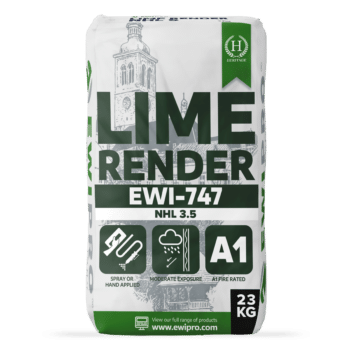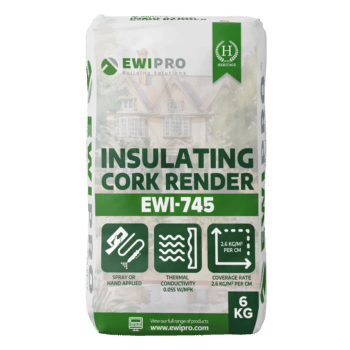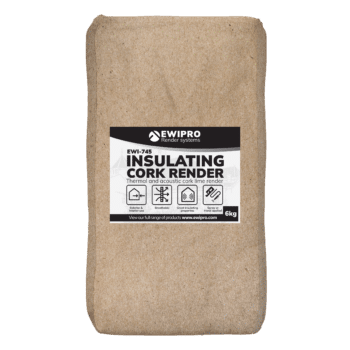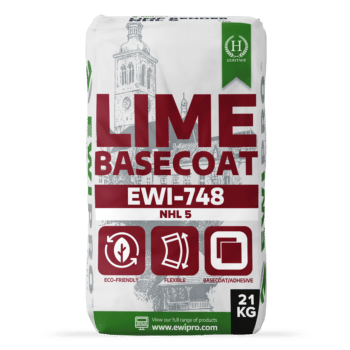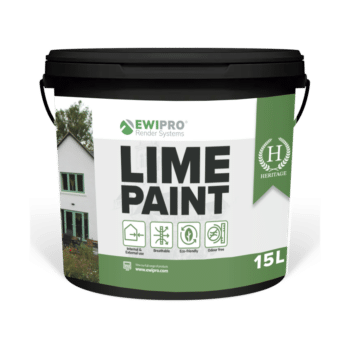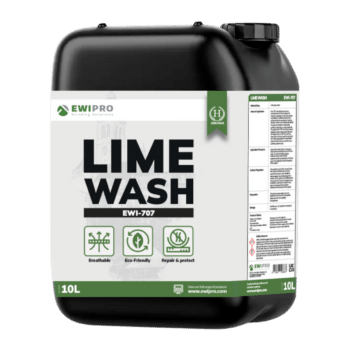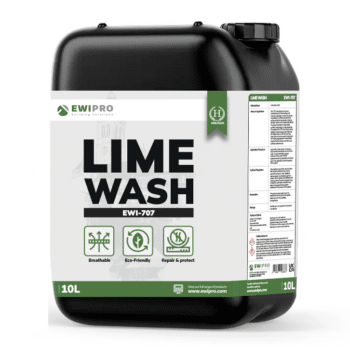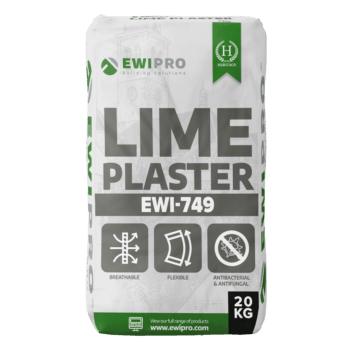Why use a Lightweight Basecoat?
Our Lightweight Basecoat is intended for use in render-only systems as a finish on properties with high-performance blocks such as Ytong, Poroton and Porotherm. The main intention of the Lightweight Basecoat is that it is a one-coat, breathable basecoat used to level the substrate before being finished with a coloured render.
Why use a Lightweight Render System with AAC blocks?
Take for example AAC blocks (autoclaved aerated concrete) such as Ytong. These are produced from autoclaved lime, sand, cement, water and a rising agent. AAC blocks are high-performance because of their thermal and acoustic insulation capabilities. They are more environmentally friendly and offer higher fire resistance than the common bricks and mortar.
You would want to use a Lightweight Basecoat with AAC blocks because these blocks tend to be a lot softer. AAC contains 60%-80% air, indicating a high insulating capacity and a softer substrate. If you were to apply a completely solid cement mortar over the soft AAC blocks, there would be an increased chance of cracking due to incompatibilities in the strengths of the cement mortar and the AAC blocks. A cement mortar would also negate the AAC block’s ability to breathe.
This is why you would use our Lightweight Basecoat. Both AAC and the Lightweight Basecoat are lightweight, soft and breathable. Therefore, when used together, the chances of cracking are minimal, and functionality is optimal.
Lightweight Basecoat and Lime
Our Lightweight Basecoat contains a key ingredient, lime. Lime has been used in construction for thousands of years. It is a truly tried and tested building material in the UK and is proven to stand the test of time—you might have noticed certain areas in the UK (e.g., Bath) where vernacular buildings are made with lime.
Lime as a component in building materials (such as in our Lightweight Basecoat) adds the benefit of breathability. We talk a lot about breathability here at EWI Store, and essentially, it means the buildings’ ability to transmit moisture. If a building is not able to expel moisture and water vapour, then damp can occur internally and externally. This can cause damage to the building structure and can also pose a health risk due to poor indoor air quality.
For these reasons, it’s incredibly important for a building to be able to breathe, which is why using our Lightweight Basecoat on breathable AAC blocks provides the perfect combination for allowing this function. Furthermore, insulation and breathability go hand in hand. Humidity and moisture can severely disrupt a buildings’ thermal performance. Because the lime within our Lightweight Basecoat is porous, it absorbs and releases humidity (it breathes), therefore helping to regulate humidity and maintain the thermal comfort of a building.
Whilst not explicitly part of our Heritage Lime Range, it does sit as an attractive alternative to Lime Basecoat. However, Lime Basecoat has the added benefit of being able to be used as an adhesive for external wall insulation. With a high-strength and high-adhesion formula, you can utilise Lime Basecoat to apply mineral wool insulation boards, which are notoriously heavy. Incorporating mineral wool insulation into heritage restoration systems is crucial to maintaining the overall breathability of the system.
-
Lime Render NHL 3.5 (EWI-747) – 23kg
Rated 5.00 out of 5£19.94 Incl. VAT£16.62 Excl. VAT -
Insulating Cork Render (EWI-745)
£23.99 Incl. VAT£19.99 Excl. VAT -
Lime Basecoat NHL 5 (EWI-748) – 21kg
£27.94 Incl. VAT£23.28 Excl. VAT -
Lime Paint – Exterior (EWI-705) – 15L
From £101.53 Incl. VATFrom £84.61 Excl. VAT -
Lime Wash (EWI-707) – 10L
£107.88 Incl. VAT£89.90 Excl. VAT -
Fine Finish Lime Plaster – Internal / External (EWI-749) – 20kg
£27.00 Incl. VAT£22.50 Excl. VAT
Applying Lightweight Basecoat
The Lightweight Basecoat is applied in a very similar way to our other basecoats. It comes in a 25kg bag and is simply mixed by hand or using a mechanical mixer with 5 litres of clean, potable water. It is then applied to the substrate by spray machine or by hand using a plastering trowel. Fibreglass mesh can also be embedded within the basecoat. The only real difference in application is that because it’s so lightweight, this basecoat can be applied up to a thickness of 25mm.
Because it’s a simple grey colour, once it has been set, it will need finishing with a decorative render. It’s essential that a breathable render is applied on top of the Lightweight Basecoat, so we recommend using either our Lime Render for a smooth finish or our mineral or silicone renders for a textured finish. These are all highly breathable and through-coloured, so they will offer both an attractive and high-performing finish.
Crucially, Lightweight Basecoat now forms an integral part of our pebbledash coverage system. One Coat Dash Cover is due to be obsolete as a product; therefore, we have been testing ways to improve our pebbledash coverage system. Through extensive testing, we have determined that Lightweight Basecoat is an exceptional alternative. As the basecoat can be applied up to 25mm in one pass, it can sufficiently smooth out and strengthen the pebbledash surface. You can then apply another pass of the basecoat, and proceed to seal the system in with our high-performance silicone renders.
Overview and technical specifications
- Highly breathable.
- Crack resistant.
- Can be applied up to 25mm thick in one pass.
- Perfect for newly built properties.
- Works well with AAC blocks – Poroton, Porotherm, Ytong.
- Can be primed and painted with a breathable render finish.
- Has a thermal conductivity of 0.47 W/(mK).
- Internal and external use.
- Composition: Portland cement, hydrated lime, mineral fillers (including perlite), admixtures
- Density once set: Approx 1.2 g/m3 class LW1
- Density of fresh mortar: Approx 1.5 g/m3
- Air content: Approx 29%
- Compressive Strength after 28 days: CSII
- Thermal conductivity coefficient (λ) (tabular value):• 0.47 W/m*K
- Water vapour diffusion factor: 7.8
- Reaction to fire: A1
- Grain size distribution: up to 1.25mm
- Adhesion to substrate and symbol of cracking model:≥ 0.4 MPa; FP: B
- Capillary water absorption: category W0
Facebook
Twitter
LinkedIn
Your cart
Trade Account Login

We use cookies on our website to give you the most relevant experience by remembering your preferences and repeat visits. By clicking “Accept All”, you consent to the use of ALL the cookies. However, you may visit "Cookie Settings" to provide personalised consent.
Manage consent
Privacy Overview
This website uses cookies to improve your experience while you navigate through the website. Out of these, the cookies that are categorized as necessary are stored on your browser as they are essential for the working of basic functionalities of the website. We also use third-party cookies that help us analyze and understand how you use this website. These cookies will be stored in your browser only with your consent. You also have the option to opt-out of these cookies. But opting out of some of these cookies may affect your browsing experience.
Necessary cookies are absolutely essential for the website to function properly. These cookies ensure basic functionalities and security features of the website, anonymously.
| Cookie | Duration | Description |
|---|---|---|
| __stripe_mid | 1 year | This cookie is set by Stripe payment gateway. This cookie is used to enable payment on the website without storing any patment information on a server. |
| __stripe_sid | 30 minutes | This cookie is set by Stripe payment gateway. This cookie is used to enable payment on the website without storing any patment information on a server. |
| _GRECAPTCHA | 5 months 27 days | This cookie is set by the Google recaptcha service to identify bots to protect the website against malicious spam attacks. |
| apbct_cookies_test | session | CleanTalk sets this cookie to prevent spam on comments and forms and act as a complete anti-spam solution and firewall for the site. |
| apbct_page_hits | session | CleanTalk sets this cookie to prevent spam on comments and forms and act as a complete anti-spam solution and firewall for the site. |
| apbct_prev_referer | session | Functional cookie placed by CleanTalk Spam Protect to store referring IDs and prevent unauthorized spam from being sent from the website. |
| apbct_site_landing_ts | session | CleanTalk sets this cookie to prevent spam on comments and forms and act as a complete anti-spam solution and firewall for the site. |
| apbct_site_referer | 3 days | This cookie is placed by CleanTalk Spam Protect to prevent spam and to store the referrer page address which led the user to the website. |
| apbct_timestamp | session | CleanTalk sets this cookie to prevent spam on comments and forms and act as a complete anti-spam solution and firewall for the site. |
| apbct_urls | 3 days | This cookie is placed by CleanTalk Spam Protect to prevent spam and to store the addresses (urls) visited on the website. |
| AWSALBCORS | 7 days | This cookie is managed by Amazon Web Services and is used for load balancing. |
| cookielawinfo-checkbox-advertisement | 1 year | Set by the GDPR Cookie Consent plugin, this cookie is used to record the user consent for the cookies in the "Advertisement" category . |
| cookielawinfo-checkbox-analytics | 11 months | This cookie is set by GDPR Cookie Consent plugin. The cookie is used to store the user consent for the cookies in the category "Analytics". |
| cookielawinfo-checkbox-functional | 11 months | The cookie is set by GDPR cookie consent to record the user consent for the cookies in the category "Functional". |
| cookielawinfo-checkbox-necessary | 11 months | This cookie is set by GDPR Cookie Consent plugin. The cookies is used to store the user consent for the cookies in the category "Necessary". |
| cookielawinfo-checkbox-others | 11 months | This cookie is set by GDPR Cookie Consent plugin. The cookie is used to store the user consent for the cookies in the category "Other. |
| cookielawinfo-checkbox-performance | 11 months | This cookie is set by GDPR Cookie Consent plugin. The cookie is used to store the user consent for the cookies in the category "Performance". |
| ct_checkjs | session | CleanTalk–Used to prevent spam on our comments and forms and acts as a complete anti-spam solution and firewall for this site. |
| ct_fkp_timestamp | session | CleanTalk sets this cookie to prevent spam on the site's comments/forms, and to act as a complete anti-spam solution and firewall for the site. |
| ct_pointer_data | session | CleanTalk sets this cookie to prevent spam on the site's comments/forms, and to act as a complete anti-spam solution and firewall for the site. |
| ct_ps_timestamp | session | CleanTalk sets this cookie to prevent spam on the site's comments/forms, and to act as a complete anti-spam solution and firewall for the site. |
| ct_sfw_pass_key | 1 month | CleanTalk sets this cookie to prevent spam on comments and forms and act as a complete anti-spam solution and firewall for the site. |
| ct_timezone | session | CleanTalk–Used to prevent spam on our comments and forms and acts as a complete anti-spam solution and firewall for this site. |
| elementor | never | This cookie is used by the website's WordPress theme. It allows the website owner to implement or change the website's content in real-time. |
| viewed_cookie_policy | 11 months | The cookie is set by the GDPR Cookie Consent plugin and is used to store whether or not user has consented to the use of cookies. It does not store any personal data. |
Functional cookies help to perform certain functionalities like sharing the content of the website on social media platforms, collect feedbacks, and other third-party features.
| Cookie | Duration | Description |
|---|---|---|
| __zlcmid | 1 year | This cookie is used by Zendesk live chat and is used to store the live chat ID. |
| bcookie | 2 years | LinkedIn sets this cookie from LinkedIn share buttons and ad tags to recognize browser ID. |
| bscookie | 2 years | LinkedIn sets this cookie to store performed actions on the website. |
| lang | session | LinkedIn sets this cookie to remember a user's language setting. |
| lidc | 1 day | LinkedIn sets the lidc cookie to facilitate data center selection. |
| UserMatchHistory | 1 month | LinkedIn sets this cookie for LinkedIn Ads ID syncing. |
Performance cookies are used to understand and analyze the key performance indexes of the website which helps in delivering a better user experience for the visitors.
| Cookie | Duration | Description |
|---|---|---|
| __utma | 2 years | This cookie is set by Google Analytics and is used to distinguish users and sessions. The cookie is created when the JavaScript library executes and there are no existing __utma cookies. The cookie is updated every time data is sent to Google Analytics. |
| __utmb | 30 minutes | Google Analytics sets this cookie, to determine new sessions/visits. __utmb cookie is created when the JavaScript library executes and there are no existing __utma cookies. It is updated every time data is sent to Google Analytics. |
| __utmc | session | The cookie is set by Google Analytics and is deleted when the user closes the browser. It is used to enable interoperability with urchin.js, which is an older version of Google Analytics and is used in conjunction with the __utmb cookie to determine new sessions/visits. |
| __utmt | 10 minutes | Google Analytics sets this cookie to inhibit request rate. |
| __utmv | 2 years | The __utmv cookie is set on the user's device, to enable Google Analytics to classify the visitor. |
| __utmz | 6 months | Google Analytics sets this cookie to store the traffic source or campaign by which the visitor reached the site. |
| sib_cuid | 6 months | Purechat uses this cookie to send data to purechat.com, to connect visitors to the reservation team and track visitors to stay on portal. |
| SRM_B | 1 year 24 days | Used by Microsoft Advertising as a unique ID for visitors. |
Analytical cookies are used to understand how visitors interact with the website. These cookies help provide information on metrics the number of visitors, bounce rate, traffic source, etc.
| Cookie | Duration | Description |
|---|---|---|
| _ga | 2 years | The _ga cookie, installed by Google Analytics, calculates visitor, session and campaign data and also keeps track of site usage for the site's analytics report. The cookie stores information anonymously and assigns a randomly generated number to recognize unique visitors. |
| _gat_gtag_UA_61069204_2 | 1 minute | Set by Google to distinguish users. |
| _gat_UA-61069204-2 | 1 minute | A variation of the _gat cookie set by Google Analytics and Google Tag Manager to allow website owners to track visitor behaviour and measure site performance. The pattern element in the name contains the unique identity number of the account or website it relates to. |
| _gcl_au | 3 months | Provided by Google Tag Manager to experiment advertisement efficiency of websites using their services. |
| _gid | 1 day | Installed by Google Analytics, _gid cookie stores information on how visitors use a website, while also creating an analytics report of the website's performance. Some of the data that are collected include the number of visitors, their source, and the pages they visit anonymously. |
| _uetsid | 1 day | This cookies are used to collect analytical information about how visitors use the website. This information is used to compile report and improve site. |
| CONSENT | 2 years | YouTube sets this cookie via embedded youtube-videos and registers anonymous statistical data. |
Advertisement cookies are used to provide visitors with relevant ads and marketing campaigns. These cookies track visitors across websites and collect information to provide customized ads.
| Cookie | Duration | Description |
|---|---|---|
| _fbp | 3 months | This cookie is set by Facebook to display advertisements when either on Facebook or on a digital platform powered by Facebook advertising, after visiting the website. |
| ANONCHK | 10 minutes | The ANONCHK cookie, set by Bing, is used to store a user's session ID and also verify the clicks from ads on the Bing search engine. The cookie helps in reporting and personalization as well. |
| fr | 3 months | Facebook sets this cookie to show relevant advertisements to users by tracking user behaviour across the web, on sites that have Facebook pixel or Facebook social plugin. |
| MUID | 1 year 24 days | Bing sets this cookie to recognize unique web browsers visiting Microsoft sites. This cookie is used for advertising, site analytics, and other operations. |
| NID | 6 months | NID cookie, set by Google, is used for advertising purposes; to limit the number of times the user sees an ad, to mute unwanted ads, and to measure the effectiveness of ads. |
| test_cookie | 15 minutes | The test_cookie is set by doubleclick.net and is used to determine if the user's browser supports cookies. |
| uuid | 6 months | MediaMath sets this cookie to avoid the same ads from being shown repeatedly and for relevant advertising. |
| VISITOR_INFO1_LIVE | 5 months 27 days | A cookie set by YouTube to measure bandwidth that determines whether the user gets the new or old player interface. |
| YSC | session | YSC cookie is set by Youtube and is used to track the views of embedded videos on Youtube pages. |
| yt-remote-connected-devices | never | YouTube sets this cookie to store the video preferences of the user using embedded YouTube video. |
| yt-remote-device-id | never | YouTube sets this cookie to store the video preferences of the user using embedded YouTube video. |
| yt.innertube::nextId | never | This cookie, set by YouTube, registers a unique ID to store data on what videos from YouTube the user has seen. |
| yt.innertube::requests | never | This cookie, set by YouTube, registers a unique ID to store data on what videos from YouTube the user has seen. |
Other uncategorized cookies are those that are being analyzed and have not been classified into a category as yet.
| Cookie | Duration | Description |
|---|---|---|
| _clck | 1 year | No description |
| _clsk | 1 day | No description |
| _uetvid | 1 year 24 days | No description available. |
| AnalyticsSyncHistory | 1 month | No description |
| apbct_pixel_url | session | No description |
| apbct_visible_fields_0 | session | No description |
| apbct_visible_fields_1 | session | No description |
| apbct_visible_fields_10 | session | No description |
| apbct_visible_fields_2 | session | No description |
| apbct_visible_fields_3 | session | No description |
| apbct_visible_fields_4 | session | No description |
| apbct_visible_fields_5 | session | No description |
| apbct_visible_fields_6 | session | No description |
| apbct_visible_fields_7 | session | No description |
| apbct_visible_fields_8 | session | No description |
| apbct_visible_fields_9 | session | No description |
| ct_checked_emails | session | No description |
| ct_has_scrolled | session | No description |
| ct_mouse_moved | session | No description |
| ct_screen_info | session | No description |
| ictf_master | never | No description available. |
| li_gc | 2 years | No description |
| m | 2 years | No description available. |
| SM | session | No description available. |
| testinfinitycookie | session | No description |
| woocommerce_show_tax | 7 days | No description available. |
| wp_woocommerce_session_c5ac76b408021294cb56bcc27eddf8a1 | 2 days | No description |


